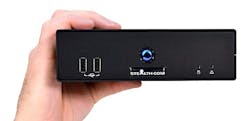Rugged mini PC for navigation, thin clients, and data acquisition introduced by Stealth
SAN JOSE, Calif., 27 June 2014. Stealth Computer Inc. in San Jose, Calif., is introducing the LPC-681 mini PC based on the 4th Gen Intel Core i7 microprocessor for embedded control, digital signs, kiosks, process control, mobile navigation, thin-clients, data acquisition, and other processor-intense applications.
The small rugged computer measures 6.54 by 6.18 by 1.89 inches, and is powered by a high-performance Intel 4th Generation Haswell Core i7-4800MQ mobile processor.
The Stealth PC is also equipped with Intel HD Graphics 4600 providing for 3-video ports (1-DisplayPort, 2-HDMI) with optional adapter cables for VGA & DVI connectivity. It can drive three 1080p HD displays or one 4K ultra HD display for high-end graphics capability.
Other features include 1-gigabit LAN, 2-USB 3.0, 2-USB 2.0, 1-serial, 2-e-SATA, audio IN/OUT PORTS AND OPTIONAl 802.11 b/g/n wireless networking.
The LPC-681 also supports as much as 16 gigabytes in DDR3L memory and ships with a 120 gigabytes solid-state disk with storage options of 240-gigabyte, 480-gigabyte, and 1-terabyte drives.
The LPC-681 operates from an external 19-volt DC power adapter (included) or can be connected to an external DC source of 12 to 20 volts DC for mobile and in-vehicle applications.
Systems are compatible with Microsoft Windows 7, 8, 8.1, Embedded, and Linux and can be custom configured. For more information contact Stealth Computer online at www.stealth.com.

John Keller | Editor
John Keller is editor-in-chief of Military & Aerospace Electronics magazine, which provides extensive coverage and analysis of enabling electronic and optoelectronic technologies in military, space, and commercial aviation applications. A member of the Military & Aerospace Electronics staff since the magazine's founding in 1989, Mr. Keller took over as chief editor in 1995.

